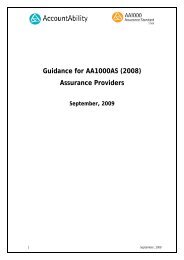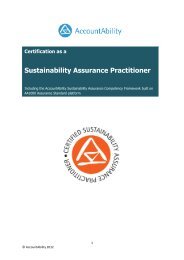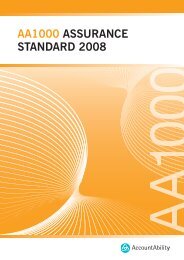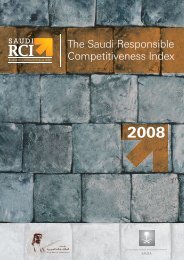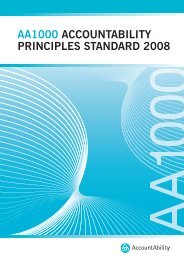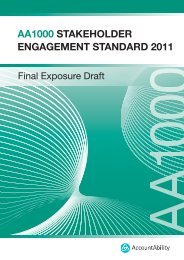The Stakeholder Engagement Manual Volume 2 - AccountAbility
The Stakeholder Engagement Manual Volume 2 - AccountAbility
The Stakeholder Engagement Manual Volume 2 - AccountAbility
You also want an ePaper? Increase the reach of your titles
YUMPU automatically turns print PDFs into web optimized ePapers that Google loves.
Introduction<br />
WHY ENGAGE?<br />
Th e past few decades have seen a shift in the role of the corporation in society.<br />
Some of the key trends causing this are the globalisation of markets, the emergence<br />
of global social and environmental challenges like HIV / Aids and climate change,<br />
as well as the decreased ability of individual national governments to address such<br />
issues by themselves. Furthermore, there is the growing infl uence of civil society<br />
organisations. One outcome of these trends is an increase in the complexity<br />
and dynamics of the operating environment for all kinds of organisations,<br />
including businesses. In order to understand and address the issues emerging out<br />
of this dynamic complexity, individual actors, whether businesses, civil society<br />
organisations or governments, are becoming increasingly dependent on sharing<br />
knowledge and working together.<br />
In this changing environment, businesses now play a more important role than ever<br />
before. Th eir activities have economic, environmental and social impacts on society<br />
from a local through to a global scale. In many countries, businesses play an active<br />
part in the shaping of public policy and regulatory developments. Furthermore, a<br />
wave of privatisation in many parts of the world, and a growing number of publicprivate<br />
partnerships has increased the role of the private sector in delivering what<br />
has traditionally been seen as public services. Th e increased involvement of private<br />
corporations in international development activities, often in co-operation with<br />
inter- and supranational bodies, is another signifi cant development in this context.<br />
In response to the enhanced role of business in society, more and more members<br />
or representatives of diff erent social groups who are impacted, claim their right to<br />
be informed of, consulted on and involved in corporate decision-making. In many<br />
developed countries, these claims have been enshrined in legislation, which requires<br />
consultation before taking potential high-impact decisions, for example on the<br />
location of an industrial production plant.<br />
THREE GENERATIONS OF CORPORATE<br />
STAKEHOLDER ENGAGEMENT 1<br />
3rd Generation<br />
Integrated strategic<br />
engagement for sustainable<br />
competetiveness<br />
2nd Generation<br />
Systematic engagement for risk<br />
management and increased understanding<br />
of stakeholders<br />
1st Generation<br />
Pressure driven engagement for pain alleviation<br />
with localised benefi ts<br />
1 See also the complementary Figure 2.6 in <strong>Volume</strong> 1 “<strong>The</strong> Guide to Practitioners’ Perspectives on <strong>Stakeholder</strong> <strong>Engagement</strong>”, p.27.



